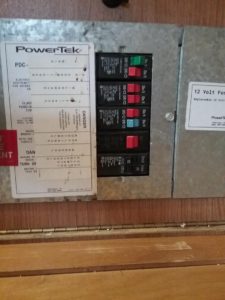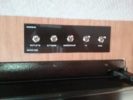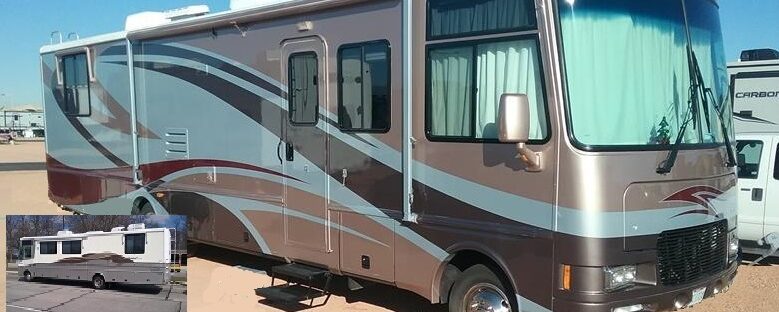UPDATE NOTE – May 2019 – After testing and installing a hard start kit, I’ve come to the conclusion this inverter has a difficult time starting the compressor on my frig. I will be installing a 2000 watt unit to see if this resolves the issue. Stay tuned..
When I installed the residential frig, obviously I wanted to be able to power it while traveling and also on the rare occasions when we stop overnight without shore power or when we boon dock.
This is the inverter I choose. Its available on Amazon ($170). The inverter is an automatic changeover if it detects 110 power. This allows us to run the frig, and maybe some other 110 volt stuff without running the generator (phone chargers, Satellite TV, ROKU unit etc.
Although this inverter can’t run several large loads simultaneously, I wanted to be able to run everything i.e. the microwave, or the morning coffee, etc..
 To do this, I needed to modify the electrical system so I could switch the different circuits between the “inverter” or the normal 120 volt feed.
To do this, I needed to modify the electrical system so I could switch the different circuits between the “inverter” or the normal 120 volt feed.
I went through the Southwind and identified all the outlets and 120 volt circuits, and what breakers feed them. There were two issues
1) The original 12 volt converter outlet was wired into the same circuit as the TV’s.
2) The Dometic Frig outlet was also on the TV’s outlet.
I want to be able to select what 110 volt items I could run on the inverter, so this meant I was going to need to add a couple new circuit breakers to the panel, and re-wire how the frig and converter got its 110 volts.
To resolve the first item, I added a new 15 amp double breaker. I made a short cord with a plug on it and wired this to one of the new breakers. The new 15 amp breaker now supplies power to the 12 volt converter.
The other 15 amp breaker will be for switched power to the new inverter. The inverter auto switches 110 volts if it sees it losses 110 volts. so this will supply the 110 volts that gets “auto switched” from the inverter.
I added 5 switches that allow me to select a circuits original 110 volt source from the breaker panel, or the inverter circuit as the source..
I bought this inverter on Amazon ($170) and plan on installing it when the weather warms up a little and I can work outside. The inverter is an automatic changeover if it detects 110 power. This will allow us to run the frig, and maybe some other 110 volt stuff without running the generator (phone chargers, Satellite TV, ROKU unit etc.
POWER
This frig draws about 0.7 amps. Rather than use the existing Frig 120 volt outlet, I’m installing an inverter so I can power the frig while on the road or when boondocking..
I checked the existing circuit breaker panel to figure out what breakers control what.
 I added a new “dual” 15 amp breaker in the bottom of the panel (hard to see in the above photo). The upper 15 amp breaker supplies 110 volts AC to the “switched 110” input of the inverter. Read below for an explanation of what the “switched 110” does.
I added a new “dual” 15 amp breaker in the bottom of the panel (hard to see in the above photo). The upper 15 amp breaker supplies 110 volts AC to the “switched 110” input of the inverter. Read below for an explanation of what the “switched 110” does.
The bottom one is wired to a new plug that powers the 12 volt converter. I made a short cord with a plug on it wired to one of the new breakers. This will be for the old converter. In the original wiring, the converter, frig, and TVs were all powered off the same breaker. This separates them into their own circuits.
 I added 5 switches that control the 110 volt circuits. I can select either the original 110 volt source or the inverter circuit as the source. This allow us to run any of the 110 volt items in the Southwind on either the normal 110 circuit or the inverter (except the A/C units). The switches also allow us to shed loads off the inverter to reduce 12 volt power consumption.
I added 5 switches that control the 110 volt circuits. I can select either the original 110 volt source or the inverter circuit as the source. This allow us to run any of the 110 volt items in the Southwind on either the normal 110 circuit or the inverter (except the A/C units). The switches also allow us to shed loads off the inverter to reduce 12 volt power consumption.
NOTE – 110 VOLT AUTO CHANGE OVER
This inverter would be great for 110 volt backup to run a few essential loads at a home and automatically switches between line power and inverter power.
To use the “switched 110” feature, the inverter needs to be wired with both, a 110 volt source and also the 12 volt batteries. The 110 volt output from the inverter can be wired to outlets or a small distribution panel. When the inverter is powered on, it detects the presence of the normal 110 volt power. If it see’s the 110 source, it switches the 110 output to the 110 volt input. If the normal 110 power is lost, the inverter detects this, and automatically starts generating its own 110 volts, and then switches the output to the internal inverter as the 110 volt source. When the normal 110 power comes back on, the inverter then switches back to the normal line power.
The inverter must be connected to 12 volts and turned on for this feature to work. If the inverter is turned off, normal 110 volts is NOT switched to the output.
This is a very powerful feature for using in a home, but because of the way I have the 110 volt systems wired in my Southwind, this feature doesn’t add any value..
I don’t want the inverter powered on if I’m not using it (phantom drain) I also added switches so I can manually connect loads to the inverter.

Pingback: Residential Frig Replacement – 1999 Southwind 35S
Any updates did you get this worked out?
I’m looking to do a similar project. I have a 2000 Southwind 32V. My initial goal is to have all the AC plugs working, microwave, and have the converter (120V to 12V) only be on when power is NOT supplied by the inverter I will be installing (12V to 120V). Additionally, I may want to run some wires for future solar panel installs.
I’m estimating a 2000W pure sine inverter should suffice, seeing that you had issues with your earlier smaller inverter.
Reading the “35S Electrical.pdf” you’ve provided (how did you get these?) – I can see there are six 120V circuits.
1. 20A Front AC
2. 20A Coffeemaker/recepts
3. 15A Gen Purp Recepts
4. 20A Microwave
5. 20A Rear AC
6. 20A Appliance
So I was expecting there to be these 6 breakers + 1 main breaker. Although from your photo, it seems you have a different setup.
1. MAIN
2. AIR CON
3. MICROWAVE
4. APPLIANCE
5. PORTABLE APPLIANCE
6. GENERAL
7. ELECTRONIC CLIMATE CONTROL
Looking at my 2000 wires, there are 7 breakers.
1. MAIN
2. AIR CONDITIONER (did not specify which AC, there are front & rear)
3. COFEE MAKER RECEPT
4. GENERAL PURPOSE
5. MICROWAVE
6. ELECTRONIC CLIMATE CONTROL
7. APPLIANCES
I suspect I have a very similar setup at my AC breaker panel but maybe not quite the same.
Some questions I had
1. Refrigerator: Is it necessary to remove the refrigerator to rewire the breakers to control what you wanted? I think my wires are probably tied up behind / above the fridge. I’d prefer not to do removal because it’s a hassle.
2. I have a storage compartment under my fridge that has a 120V plug. Perhaps I can feed the output of my inverter to this plug, thus making it live, and all the plugs on this circuit would be “on” – this would probably be the easiest amount of work – I won’t have ALL the plugs working, but that’s probably ok. Just some. I’d have to rewire the circuit otherwise.
3. Mount location: Why did you mount the inverter outside in a compartment? How far is it from the battery? I see that you used fairly thick wires for your AC output. What gauge wire do you use for 12V and the 120V outputs and how long are they? Did you run new wires from the battery to the inverter or tap into the existing wires from battery?
4. Automatic switchover: I see your inverter has auto switch over but you are not using it – so I don’t plan to buy an inverter with that feature. I planned to manually turn the converter off then turn the inverter on – but would prefer having the inverter always on unless shore / generator power is available. What do you recommend for this setup?
5. Auto generator start on low battery: Have you thought about doing this upgrade https://mybounder.com/2022/04/17/add-on-auto-gen-start/ using a Onan Energy Command 30?
1) I’m not sure. I had the frg out anyway when I installed the residential, so that was a good time to run the wires.
3) Batt wires are #0. I also added a 150 amp[ breaker/disconnect so I can turn power off to the inverter when I’m not using it.
4) I prefer that the inverter isn’t on unless I’m using it.
5) I don’t do a lot of boondocking, but the generator controller I’m working on as part of the Waiter ECC has an auto start function